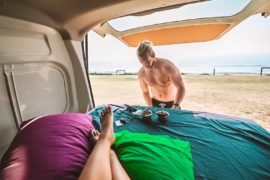Bhutan is a photographer’s paradise. I have been a photography lover since high school, and taking photos on my travels around the world has been a serious hobby of mine for as long as I can remember. Once we booked a trip to Bhutan, I knew I needed to research and plan to get the most out of the photographic opportunities there.
What I found was that photographing Bhutan was not difficult, once I relaxed and simply focused on what made it so unique and beautiful. I did not fuss so much over settings, save for ISO as light is a focal point on its own in Bhutan, and instead went for subjects and composition. I am happy with the photographs I got in Bhutan and I’d love to share my tips for shutterbugs who are planning on visiting the Kingdom of the Thunder Dragon!
Capturing Bhutan
No matter if your purpose is to share your photos on Facebook, Instagram, your travel blog, or a professional portfolio, you’ll want to capture the unique essence of Bhutan. You can plan on capturing images in the following categories in order to convey a wide variety of Bhutan stories.
Man MadePrayer flags, rice terraces, markets, suspension bridges, and trails. |
LocalsChildren, monks, nuns, police, men in gohs, women in kiras, and dogs. |
Nature and LandscapesSweeping vistas, vast skies, sprawling forests and rolling green mountains. |
Traditional ArtsDzong and temple architecture, Buddhist paintings and sculptures, and prayer wheels. |
Bhutan Photography Tips
I’ve collected some tips that helped me along the way. These will not so much be from a technical standpoint as I am not a professional photographer. Rather, I am seeking to provide some tips that anyone could use, with any camera, to best capture your once in a lifetime trip to Bhutan. Remember, the best camera is the one you have with you!
Balance
Bhutan is best seen through your own two eyes, not the viewfinder. Look with your eyes and enjoy the moment before you point and shoot. Aim for the natural shots that come from being patient and going slow, instead of obsessing over one subject. There will be another incredible shot around the corner, because that’s how beautiful Bhutan is!
Respect People
When you arrive in Bhutan, you’ll instantly feel that it’s a land in which people show immense respect to each other and immense respect to customs. Simply asking permission of your subjects not only improves the quality and authenticity of your photos, but makes you feel like a more responsible and involved tourist.
Respect Places
Ask your guide about rules regarding where to take photographs. He or she will likely say that whenever your shoes have been removed (when entering a temple), photos are not permitted.
Relaxation
When approaching a subject you want to photograph, engage with that person a little bit and don’t be too uptight. Say, hello, how are you? Again, make sure they don’t mind their photo taken, and then close the shutter. Not a single person I asked refused to have their photo taken, and I must have asked dozens of times! Most people even posed for me!
Continuous Mode
Try out your camera’s continuous shooting mode, available on most smartphones and digital cameras. When shooting a moving subject such as an archer, it will take a burst of photos, allowing you to choose the one with the best emotion and expression. Often, my favourite photos of a subject are shot in continuous mode and taken after the person releases their pose.
Timing
Early in the morning and late afternoon are the best times to take photos. The lighting can be pretty harsh in between these times.
Breaking it Down
It’s tough to capture the beauty and immensity of a Dzong or a Temple through one photograph. Instead, break it down into smaller parts in order to convey the essence of the place you’re photographing. For a Dzong, you might capture the intricate wall carvings, a dog lounging in a sunbeam with a Buddhist painting blurred in the background, the old staircases, a striding monk, and a child peeking through a doorway. Placed alongside a photo of the entire Dzong, you will convey a carefully tied-together series of photos that tells a story of that Dzong to the viewer.
Travel Light
Yes, a tripod would have been fantastic for crisp zoomed-in shots. I maybe even regretted leaving my 16-35mm and 35mm lenses at home for those wider angles. However, I enjoyed the freedom and the challenge of working only with what I had (an iPhone, my Sony a6500, 50mm lens, and 55-210mm lens). Never once did I feel burdened, frustrated, or weighed down by the gear that I brought.
Bring Adapters
You’re going to want to charge your gear up at night in the hotel. North American plugs will not fit without an adapter, so be sure to bring yours along. Voltage in Bhutan is 230V. In general, cameras are compatible with 100-240V, so a simple adapter will be all you need to stay charged!
Blend In
Bhutan has a colour scheme built into the natural and man-made landscape. Dark crimson, yellow, brown, and white structures just barely stand out from the rich green coniferous trees. You’ll notice that the traditional clothing the locals wear blend in seamlessly with the surroundings. If you plan on being a subject in some of your photos, you might want to consider a neutral outfit palate so that you do not clash with the natural beauty of the Bhutanese countryside.
Alli’s Photography Gear for this trip
- Camera: Sony a6500
- Lens: Sony E 50mm f/1.8 OSS; Sony E 55-210mm f/4.5-6.3 OSS
- Have you ever been to Bhutan?
- If yes, where is your favourite place to take photos? Share them with us in the comments!
- Don’t forget to book your travel insurance before travelling!
If you like this article, sign up to AdventureFaktory’s E-mail list to keep up with new posts and updates! We also invite you to support our Viet Nam based Travel Writer Alli on @Allirtgr & SaigonBased.com





